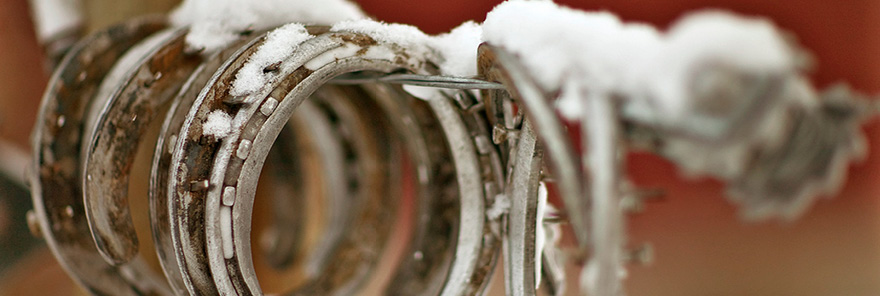Ah, it’s time for winter shoes.
Bring out the boots: waterproof, shearling-lined, insulated, bulky boots. The ones for stomping through mud and slush and snow for another season. Put away your flip-flops; hide them somewhere, you don’t want to be reminded of them mid-winter, or you’ll find yourself on a plane to the Caribbean before you’ve sorted out a barn-sitter.
But what about your horse? His winter boots need consideration, too. From occasional ice to heavy snows, no matter where you live, if the seasons are affecting your choice in footwear, they should be affecting your horse’s, too.
Two of the biggest concerns in winter riding are traction and snowballing. The latter can be contained with a home remedy like using petroleum jelly or cooking spray to coat the bottom of the hoof, or with snow pads added between the hoof and the shoe. But traction requires a more aggressive approach. Here are a few options for adding traction to your horse’s hooves this winter:
Barefoot is beautiful: if your horse already has a healthy, well-formed hoof, is used to going barefoot, and is kept in steady work — or isn’t working at all. It should come as no surprise that the hoof is naturally designed to handle slick surfaces, and the frog is a natural snow-expeller. A wide healthy frog will push out the snow that likes to ball up in a shod hoof. But horses with narrow frogs or who aren’t used to going barefoot could suffer in the snow, developing snowballs and traction problems in unbalanced hooves.
Winter boots: You can keep them going shoeless with hoof boots: most major hoof boot manufacturers offer a winter weather model which might include such options as snow rim pad or calks for icy terrain. There are also plastic shoes offering flexibility and traction that slick steel or aluminum shoes just don’t have.
Traditional traction: If your horse wears traditional horse shoes and you’ll be working on hard or frozen ground this winter, you can add traction with borium. Added by your farrier when shoes are being shaped for the hoof, borium is essentially extra knobs of metal welded to the bottom of the shoe. It grabs the ground and provides serious traction, but the security can come with a price: the grip of shoe on ground prevents the hoof from naturally swiveling with each step. Whether or not this can lead to long-term soundness issues is a matter up for debate.
New nails: Ice nails and Dura-Tec nails are two types of horseshoe nail that can add traction to a regular horse shoe. Ice nails extend beyond the shoe’s surface to grip and bite into the ground; they are made from the same material as horseshoe nails and act as a cleat or stud. Dura-Tec nails are treated metal much like borium; with extra-hard heads that bite into the ground.
Studs: Just like the studs used in eventing or show-jumping, you can add studs for winter riding. Screw-in studs are temporary, meant to be used only for your riding session and then removed. Drive-in studs, much smaller than screw-ins, are added by your farrier and are permanent, acting much as borium does.
All of these options can work differently according to your footing, your riding plans, and your horse’s hoof, so it’s important to discuss them with your farrier and determine a winter weather hoofcare plan that is right for your horse. But no matter which course of action you take, you and your horse will both be kitted out in great winter boots — and don’t you feel stylish!


